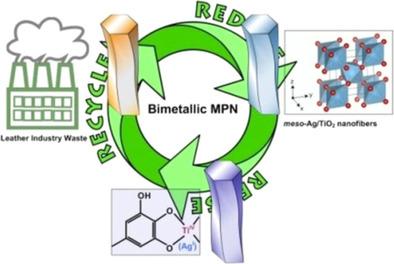当前位置:
X-MOL 学术
›
Chem. Asian J.
›
论文详情
Our official English website, www.x-mol.net, welcomes your
feedback! (Note: you will need to create a separate account there.)
Thermal Transition of Bimetallic Metal–Phenolic Networks to Biomass‐Derived Hierarchically Porous Nanofibers
Chemistry - An Asian Journal ( IF 3.5 ) Pub Date : 2018-03-15 , DOI: 10.1002/asia.201800284 Gao Xiao 1, 2, 3 , Wei Chen 1 , Fan Tian 4 , Joseph J. Richardson 5 , Blaise L. Tardy 6 , Minghua Liu 1 , Neel S. Joshi 2 , Junling Guo 2
Chemistry - An Asian Journal ( IF 3.5 ) Pub Date : 2018-03-15 , DOI: 10.1002/asia.201800284 Gao Xiao 1, 2, 3 , Wei Chen 1 , Fan Tian 4 , Joseph J. Richardson 5 , Blaise L. Tardy 6 , Minghua Liu 1 , Neel S. Joshi 2 , Junling Guo 2
Affiliation

|
The development and utilization of biomass resources could contribute to new materials for long‐term sustainable energy storage and environmental applications, reduce environmental impacts, and meet the urgent need for green and sustainable development strategies. Herein, a bimetallic metal–phenolic network (MPN) was applied to incorporate different metallic element species into cattle skin and fabricate collagen‐fiber‐derived complex oxide nanofibers using natural polyphenols (Myrica tannins). Direct thermal transition of these biomass–MPN composites generates hierarchically porous nanofibers possessing micro‐ and mesoporous architectures along with a well‐preserved macroscopic structure. The pore system and complex oxide composition provide excellent photocatalytic performance. This low‐cost, simple, and readily scalable MPN‐based approach provides a straightforward route to synthesize nanostructured materials directly from biomass, which could play important roles in a wide range of potential applications.
中文翻译:

双金属金属-酚醛网络热转变为生物质衍生的多孔纳米纤维。
生物质资源的开发利用可以为长期可持续的能源存储和环境应用提供新材料,减少对环境的影响,并满足对绿色和可持续发展战略的迫切需求。本文中,使用双金属金属-酚醛网络(MPN)将不同的金属元素种类掺入牛皮肤,并使用天然多酚制备胶原纤维衍生的复合氧化物纳米纤维(Myrica单宁)。这些生物质-MPN复合材料的直接热转变产生具有微孔和中孔结构以及保存完好的宏观结构的分层多孔纳米纤维。孔系统和复合氧化物组合物具有出色的光催化性能。这种基于MPN的低成本,简单且易于扩展的方法为直接从生物质合成纳米结构材料提供了一条直接途径,这可能在广泛的潜在应用中发挥重要作用。
更新日期:2018-03-15
中文翻译:

双金属金属-酚醛网络热转变为生物质衍生的多孔纳米纤维。
生物质资源的开发利用可以为长期可持续的能源存储和环境应用提供新材料,减少对环境的影响,并满足对绿色和可持续发展战略的迫切需求。本文中,使用双金属金属-酚醛网络(MPN)将不同的金属元素种类掺入牛皮肤,并使用天然多酚制备胶原纤维衍生的复合氧化物纳米纤维(Myrica单宁)。这些生物质-MPN复合材料的直接热转变产生具有微孔和中孔结构以及保存完好的宏观结构的分层多孔纳米纤维。孔系统和复合氧化物组合物具有出色的光催化性能。这种基于MPN的低成本,简单且易于扩展的方法为直接从生物质合成纳米结构材料提供了一条直接途径,这可能在广泛的潜在应用中发挥重要作用。











































 京公网安备 11010802027423号
京公网安备 11010802027423号